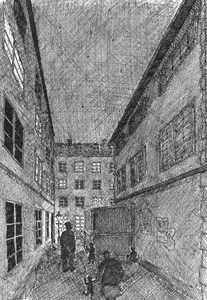Hans Christian Andersen and the matches
The fairy tale " The little match girl " was written on 18th of
November 1845 ,
while Hans Christian
Andersen stayed at Gråsten Palace ahead of one of his long trips
abroad .
The occasion for the adventure was a call from the editor of the
Danish People's Calendar , Andreas Flinch , to write a story
based on a drawing of J.Th.
Lundbye depicting a little girl with some sticks in her hand and
with the tagline : Do well when you give .
Hans Christian
Andersen had not been given notice of the letter in a while ,
but now he felt that he had to get this out of the way before he
set out on his journey.
Besides
the drawing there have been many theories about what has
inspired him to the fairy tale - thoughts about his mother and
his childhood etc. .
But there is little evidence to suggest a much more earthy
inspiration for the fairy tale.
For the
period up to the departure Hans Christian
Andersen
lived, as many times before, at the Hotel d' Angleterre,
which was next door to the first matchstick factory in Denmark ,
namely Rohmell & Schüerers factory in the small street "Bag
Hovedvagten" (Behind the Main Gate") .
It is
indisputable from some of Hans Christian
Andersen's letters that his tailor and shoemaker lived in the
same building as the factory was located and that his benefactor
Jonas Collins son, Gottlieb Collin also lived in this building,
on the second floor . Hans Christian
Andersen corresponded cordially with Gottlieb and were many
times on visits , and he welcomed that the Collin family was
gathered at Gottlieb during the cholera epidemic , which avoided
the area behind the Main Gate .
At the same time Jonas Collin stayed at the Collin
residens in Bredgade (Broad Street) , why HC
Andersen often must have passed through Bag Hovedvagten, to
avoid the rather dark Kongens Nytorv and can not have failed to
encounter the children who came to and from the factory.
In 1845 , there were behind the main guard building an extension
, rather a kind of garage for the local fire engine , "head
guard fire engine".
If you study old pictures of the Main Gate , you can see the
expansion at d' Angleterre-side , but of correspondence from P.
Rohmell it appears this the expansion , which was a urinal ,
first performed later.
The extension behind the main guard , may well have served as
the hook at the house where the little girl is sitting with her
match sticks .
It
is therefore obvious that Hans Christian
Andersen 's fairy tale actually have one of the first
descriptions of the poor children who work on the match
factories.
 H.C. Andersen in the narrow street Bag
Hovedvagten (Main gate buiding at the right) with Rohmells
building to the left. In the background to the right you see the
fire engine building and the corner, where the little girl was
sitting.
H.C. Andersen in the narrow street Bag
Hovedvagten (Main gate buiding at the right) with Rohmells
building to the left. In the background to the right you see the
fire engine building and the corner, where the little girl was
sitting.
(Poul Low Møllers illustration from the book, Svovlstikkerne)
